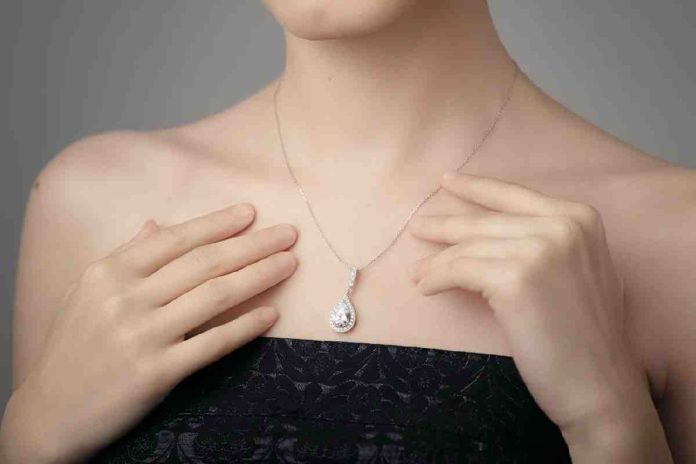Discover the Perfect Pairings
Key Takeaways:
- Elegant pendants have a special way of capturing attention and making a stylish statement.
- Pendants have a long and intriguing history, symbolizing status, beliefs, and cultural identity.
- Pendants come in various styles and can be worn in different ways, making them versatile.
- Consider personal style, occasion, and materials when choosing a pendant.
- Chains hold pendants in place and add sparkle, with different styles like delicate and bold.
- Gold, silver, and stainless steel are popular chain materials, each offering unique qualities.
- To create harmonious combinations, consider the overall aesthetic and weight of pendant and chain.
- Pair pendants and chains to create your signature style, mixing metals and gemstones for variety.
- Personalize pendant and chain combinations through engraving and birthstone selection.
- Care for your pendants and chains by removing during harsh activities and regular cleaning.
- Properly store and handle your jewelry to preserve their beauty and prevent damage.
1. The Charm of Elegant Pendants: A Stylish Statement
Elegant pendants have a special way of capturing attention and making a stylish statement. These exquisite pieces of jewelry have been worn by men and women for centuries, adding a touch of elegance and charm to any outfit. But beyond their beauty, pendants carry a rich symbolism that makes them even more captivating. Let’s explore the history and symbolism of pendants and how they have become a versatile fashion accessory today.
1.1 The History and Symbolism of Pendants
Pendants have a long and intriguing history dating back to ancient civilizations. They were worn by Egyptians, Greeks, and Romans as symbols of status, beliefs, and cultural identity. Ancient Egyptians believed that pendants represented protection and favored those adorned with amulets and talismans. In Greek and Roman culture, pendants were often engraved with mythological figures and worn as a way to honor gods and goddesses.
In more recent history, pendants have been associated with love, luck, and spirituality. The tradition of giving pendants as gifts has been passed down through generations, symbolizing a deep connection and affection between the giver and the receiver. Today, pendants continue to hold personal meaning for many individuals, serving as reminders of cherished memories or representing a specific belief or value.
1.2 Types of Pendants and Their Versatility
Pendants come in a wide variety of styles, shapes, and materials, making them incredibly versatile. From delicate gold lockets to bold gemstone statement pendants, there is a pendant to suit every taste and occasion. Some popular pendant styles include heart-shaped pendants, cross pendants, initial pendants, and nature-inspired pendants like flowers or animals.
The versatility of pendants allows them to be worn in various ways. They can be paired with different chains to create unique looks, worn alone as a statement piece, or layered with other necklaces for a trendy, bohemian vibe. Pendants also make excellent gifts, as they can be personalized to reflect the recipient’s interests, birthstone, or initials.
1.3 Choosing the Perfect Pendant: Considerations and Tips
When choosing a pendant, there are several factors to consider to ensure you find the perfect piece. First, think about your personal style and the occasions you plan to wear the pendant. If you prefer a minimalist look, a small, simple pendant may be more suitable. On the other hand, if you love making a bold statement, a larger, eye-catching pendant could be the way to go.
Consider the materials used in the pendant as well. Gold and silver are classic choices that exude elegance and timeless beauty. Gemstone pendants add a pop of color and can be selected based on birthstone or personal preference. It’s also important to think about the quality of the pendant and ensure it is well-crafted to withstand everyday wear.
Lastly, pay attention to the chain that will accompany your pendant. The chain should complement the pendant in terms of style, length, and overall aesthetic. Delicate chains work well with dainty pendants, while thicker chains can handle the weight of larger, more substantial pendants.
2. Unveiling the World of Sparkling Chains
While pendants steal the spotlight, the role of chains should not be underestimated. Chains are the unsung heroes that hold pendants in place and add an extra touch of sparkle and sophistication to any necklace. Let’s delve into the different styles of chains, the importance of chain materials, and how to create harmonious combinations with pendant designs.
2.1 The Different Styles of Chains: From Delicate to Bold
Chains come in a plethora of styles, each offering a distinct look and feel. Delicate chains, such as the classic cable chain or the elegant Singapore chain, are perfect for those who prefer a subtle and understated look. These chains have fine links that create a delicate shimmer, adding a touch of femininity to any pendant.
For those who enjoy a bolder statement, chain with pendant are more substantial links like the curb chain or the Figaro chain are excellent options. These chains have larger, more prominent links that create a sense of confidence and boldness. They pair well with larger pendants or can be worn on their own as a statement piece.
2.2 The Importance of Chain Materials: Durable and Luxurious
When it comes to chain materials, there are various options to choose from, each with its unique qualities. Gold chains, whether in yellow, white, or rose gold, are a popular choice for their luxurious appearance and durability. Gold is a precious metal that is resistant to tarnishing and offers a timeless elegance that never goes out of style.
Silver chains, particularly sterling silver, are another popular option. Sterling silver chains are more affordable than gold yet still offer a sophisticated and polished look. They are a great choice for those who want the beauty of precious metal without the higher price tag.
For those who prefer something with an edgier look, stainless steel chains are an excellent choice. Stainless steel is a durable and hypoallergenic material that can withstand everyday wear and is highly resistant to tarnishing. It is often used in modern and industrial-inspired pendant designs.
2.3 Matching Chains to Pendant Designs: Creating Harmonious Combinations
To create a harmonious combination between a pendant and its chain, it’s essential to consider the overall aesthetic and style of both pieces. A delicate pendant with intricate details may get lost on a bold, chunky chain, while a large and bold pendant may overwhelm a delicate chain.
Consider the size and weight of the pendant when selecting a chain. Heavier pendants require a sturdier chain that can support their weight without compromising comfort. Additionally, take into account the color and material of the pendant when choosing a chain. A gold pendant may pair perfectly with a gold chain, while a colorful gemstone pendant may benefit from a simple silver or stainless steel chain to let the gemstone shine.
Experimenting with different pendant and chain combinations can also lead to exciting and unique looks. Mixing metals and textures can create a striking contrast that adds depth and interest to your jewelry. Don’t be afraid to think outside the box and try unexpected pairings. The key is to find a balance that highlights the beauty of both the pendant and the chain.
3. Creating Your Signature Style: Pairing Pendants and Chains
The combination of pendants and chains offers endless possibilities for creating your signature style. Whether you prefer a minimalist, classic look or a bold and eclectic one, there are ways to make your pendant and chain combinations reflect your unique personality and fashion preferences. Let’s explore some tips for finding the perfect balance, enhancing your overall look, and personalizing your pendant and chain combinations.
3.1 Finding Balance: Choosing the Right Pendant Size for Your Chain
Achieving a balanced look is crucial when pairing pendants and chains. The size of the pendant should be proportional to the length and thickness of the chain. A small pendant on a long, chunky chain may look overwhelmed, while a large pendant on a delicate chain may appear out of place.
Consider the occasion and your personal style when choosing the right pendant size. For everyday wear and a more subtle look, opt for smaller pendants that sit closer to the neckline. On the other hand, for special occasions or when you want to make a statement, go for larger pendants that can be easily seen and admired.
3.2 Enhancing the Overall Look: Mixing Metals and Gemstones
Mixing metals and gemstones is a great way to add variety and interest to your pendant and chain combinations. The contrast between different metals, such as gold and silver, creates a visually appealing look that can be trendy and eye-catching. Similarly, incorporating gemstones into your combinations can add a pop of color and bring vibrancy to your jewelry.
When mixing metals and gemstones, it’s important to consider the overall color palette and ensure that the different elements harmonize with each other. For example, pairing a blue topaz pendant with a silver chain can create a serene and elegant combination, while a ruby pendant on a gold chain can exude warmth and luxury.
3.3 Customizing Your Pendant and Chain Combinations: Personalization Tips
One of the most exciting aspects of pendant and chain combinations is the ability to personalize them according to your own preferences and style. Personalization can be achieved through various means, such as engraving initials or names on the pendant or selecting birthstone pendants that hold special significance.
Consider the meaning and symbolism behind certain gemstones or symbols when customizing your pendant and chain combinations. For example, a heart-shaped pendant with the birthstone of a loved one represents deep affection and connection. Adding such personal touches makes your jewelry truly unique and tells a story that is meaningful to you.
4. Caring for Your Pendants and Chains: Maintenance and Cleaning
To keep your pendants and chains looking their best, proper care and maintenance are essential. By following some simple practices, you can ensure that your jewelry always sparkles and remains in pristine condition. Let’s explore some best practices for caring for your pendants and chains, as well as cleaning and storage techniques.
4.1 Best Practices to Keep Your Jewelry Sparkling
To prevent damage to your pendants and chains, it’s important to remove them when engaging in activities that may expose them to harsh chemicals or physical stress. Avoid wearing your jewelry when swimming, exercising, or performing household chores. Additionally, applying perfume, lotions, and hairspray before putting on your jewelry can help prevent tarnishing and discoloration.
Regularly inspect your pendants and chains for any signs of damage or wear and tear. Look for loose clasps or links that may need repair. If you notice any issues, it’s best to take your jewelry to a professional jeweler to ensure proper and safe restoration.
4.2 Cleaning and Polishing Techniques for Pendants and Chains
Cleaning your pendants and chains regularly will help maintain their shine and luster. Begin by gently removing any dirt or debris from the surface using a soft-bristled brush or a microfiber cloth. To clean gold or silver jewelry, mix a small amount of mild dish soap with warm water and soak the pendant and chain for a few minutes. Gently scrub them with a soft brush, rinse thoroughly, and pat dry with a clean cloth.
For stainless steel chains, a mixture of warm water and mild soap can also be used. Alternatively, you can use specialized stainless steel cleaners to remove any dirt or smudges. Be sure to follow the manufacturer’s instructions when using cleaning products.
4.3 Proper Storage and Handling: Preserving the Beauty of Your Pieces
Proper storage and handling are crucial for preserving the beauty of your pendants and chains. When not in use, store your jewelry in a clean, dry, and preferably lined jewelry box or pouch to protect them from dust, moisture, and scratches. If storing multiple pieces together, consider using separate compartments or individual pouches to avoid tangling and rubbing against each other.
When handling your pendants and chains, take care to avoid pulling or tugging on them forcefully, as this can lead to damage or breakage. Put on your jewelry after applying makeup, lotions, and perfumes to avoid exposing them to potentially harmful chemicals.
In conclusion, elegant pendants and chains offer a myriad of options for creating stylish and personalized jewelry combinations. By understanding the history and symbolism of pendants, exploring different chain styles and materials, and considering factors such as pendant size and personalization, you can create unique and captivating looks. Remember to care for your pendants and chains properly to ensure they remain sparkling and beautiful for years to come. Whether you’re looking to make a statement or add a subtle touch of elegance, the perfect pendant and chain combination is waiting to enhance your style.
FAQ
Question 1: What is the history and symbolism of pendants? – Pendants have a long and intriguing history, dating back to ancient civilizations such as the Egyptians, Greeks, and Romans. They were worn as symbols of status, beliefs, and cultural identity. Today, they continue to hold personal meaning and can represent cherished memories or specific beliefs.
Question 2: What are the different types of pendants and how versatile are they? – Pendants come in various styles, shapes, and materials, making them incredibly versatile. From delicate gold lockets to bold gemstone statement pendants, there is a pendant to suit every taste and occasion. They can be worn in different ways, paired with different chains, or layered with other necklaces for a trendy look.
Question 3: What should I consider when choosing a pendant? – When choosing a pendant, consider your personal style, the occasions you plan to wear it, and the materials used. Think about whether you prefer a minimalist or bold look, and select a pendant that matches your preferences. Additionally, pay attention to the quality of the pendant and ensure it is well-crafted.
Question 4: Why are chains important in pendant necklaces? – Chains hold pendants in place and add an extra touch of sparkle and sophistication to any necklace. They come in various styles, from delicate to bold, and can complement different pendant designs.
Question 5: What are the different styles and materials of chains? – Chains come in a plethora of styles, from delicate cable chains to bold curb chains. They can be made of materials such as gold, silver, and stainless steel. Each material offers unique qualities, such as the luxurious appearance and durability of gold, the affordability and sophistication of silver, and the durability and hypoallergenic properties of stainless steel.
Question 6: How can I create harmonious combinations with pendant and chain designs? – To create harmonious combinations, consider the overall aesthetic and style of both the pendant and chain. Ensure that the size and weight of the pendant are suitable for the chain chosen. The color and material of the pendant should also be taken into account when selecting a chain. Experimenting with different combinations can lead to unique and striking looks.
Question 7: How can I personalize my pendant and chain combinations? – Personalization can be achieved through various means, such as engraving initials or names on the pendant or selecting birthstone pendants. Consider the meaning and symbolism behind certain gemstones or symbols to create personalized combinations that reflect your unique style and story.
Question 8: How should I care for my pendants and chains? – To care for your pendants and chains, it is important to remove them during activities that may expose them to harsh chemicals or physical stress. Regularly inspect them for any signs of damage or wear. Clean them using gentle methods, such as using a soft brush and mild soap, and store them properly in a clean, dry jewelry box or pouch to prevent damage.


















